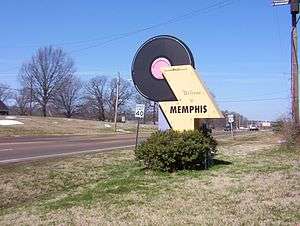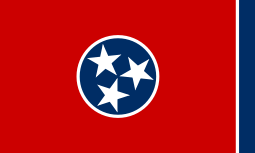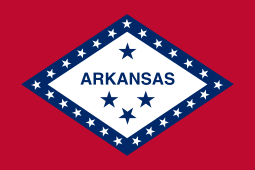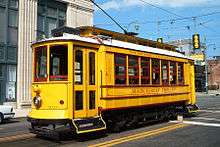Arlington, Tennessee
| Arlington, Tennessee | |
|---|---|
| Mayor: Mike Wissman | |
 Location in Shelby County and state of Tennessee. | |
| Coordinates: 35°16′40″N 89°40′24″W / 35.27778°N 89.67333°W | |
| Country | United States |
| State | Tennessee |
| County | Shelby |
| Area | |
| • Total | 20.4 sq mi (52.9 km2) |
| • Land | 20.4 sq mi (52.9 km2) |
| • Water | 0.0 sq mi (0.0 km2) |
| Elevation | 282 ft (86 m) |
| Population (2010) | |
| • Total | 11,517 |
| • Density | 560/sq mi (220/km2) |
| Time zone | Central (CST) (UTC-6) |
| • Summer (DST) | CDT (UTC-5) |
| ZIP code | 38002 |
| Area code(s) | 901 |
| FIPS code | 47-01740[1] |
| GNIS feature ID | 1304869[2] |
| Website | www.townofarlington.org |
Arlington is a town in Shelby County, Tennessee. The population was 2,569 at the 2000 census and 11,517 at the 2010 census,[3] for a gain of 348.3% during the decade. The 2010 US Census shows that Arlington is the 2nd fastest growing community in the State of Tennessee.[4] It is one of seven municipalities in Shelby County.
History
Arlington has been called Shelby County’s best-kept secret,[5] as it has remained a small quiet rural town for two centuries.
Settlers came to the area in the 1830s, and many of their descendants still live in the town. Originally known as Haysville,[6] the town was named after the original landowner, Samuel Jackson Hays, a nephew of President Andrew Jackson. The area began to grow with the development of the Memphis and Ohio Railroad and the creation of Withe Depot within its boundaries. By 1856, about 200 people called Haysville home. The outbreak of yellow fever in Memphis in 1878 contributed to the stagnant population as the town fathers quarantined the area, forbidding outsiders from entering the town. The town was incorporated as Haysville in 1878.[6]
In 1883 the town's name was changed to Arlington due to the post office being unable to use the name Haysville. In 1900 the town was incorporated again. Captain Henry Pittman, who lived in Haysville, had visited Washington, D.C. and Arlington National Cemetery and was inspired to call the town Arlington.[6]
Geography
According to the United States Census Bureau, the town has a total area of 20.4 square miles (53 km2), of which 0.05% is water.[7]
Demographics
| Historical population | |||
|---|---|---|---|
| Census | Pop. | %± | |
| 1890 | 343 | — | |
| 1910 | 477 | — | |
| 1920 | 494 | 3.6% | |
| 1930 | 446 | −9.7% | |
| 1940 | 440 | −1.3% | |
| 1950 | 463 | 5.2% | |
| 1960 | 620 | 33.9% | |
| 1970 | 1,349 | 117.6% | |
| 1980 | 1,778 | 31.8% | |
| 1990 | 1,541 | −13.3% | |
| 2000 | 2,569 | 66.7% | |
| 2010 | 11,517 | 348.3% | |
| Est. 2015 | 11,625 | [8] | 0.9% |
| Sources:[9][10] | |||
2010 Census
As of the census[1] of 2010, there were 11,517 people, and 3,739 households. The population density was 565 people per square mile (48.6/km²). The racial makeup of the town was 81.24% White, 13.84% African American, 0.16% Native American, 1.80% Asian, 0.86% from other races, 2.08% from two or more races, and .02% from Native Hawaiian and Other Pacific Islander. Hispanic or Latino of any race were 2.98% of the population.[11]
There were 3,739 households out of which 35.23% were 1-2 person occupied, 48.02% were 3-4 person occupied, 15.32% were 5-6 person occupied, 1.42% were 7 or more person households and 4.2% were listed as unoccupied.
In the town the population was spread out with 37.53% under the age of 18, 3.47% from 18 to 24, 35.62% from 25 to 44, 19.20% from 45 to 64, and 4.19% who were 65 years of age or older.[4] The median age was 32.2 years. The population was 49% male and 51% female.[12]
The estimated median income for a household in 2009 was $82,272, and the median income for a family was $85,779. The per capita income for the town was $29,468.[13]
2000 Census
As of the census[1] of 2000, there were 2,569 people, 794 households, and 669 families residing in the town. The population density was 125.8 people per square mile (48.6/km²). There were 928 housing units at an average density of 45.4 per square mile (17.5/km²). The racial makeup of the town was 74.23% White, 23.01% African American, 0.47% Native American, 0.62% Asian, 0.54% from other races, and 1.13% from two or more races. Hispanic or Latino of any race were 1.13% of the population.
There were 794 households out of which 42.8% had children under the age of 18 living with them, 67.1% were married couples living together, 13.5% had a female householder with no husband present, and 15.7% were non-families. 12.2% of all households were made up of individuals and 5.7% had someone living alone who was 65 years of age or older. The average household size was 2.88 and the average family size was 3.15.
In the town the population was spread out with 26.1% under the age of 18, 5.8% from 18 to 24, 37.6% from 25 to 44, 22.6% from 45 to 64, and 8.0% who were 65 years of age or older. The median age was 36 years. For every 100 females there were 97.5 males. For every 100 females age 18 and over, there were 92.8 males.
The median income for a household in the town was $52,870, and the median income for a family was $55,602. Males had a median income of $38,438 versus $29,138 for females. The per capita income for the town was $19,569. About 3.1% of families and 11.3% of the population were below the poverty line, including 4.4% of those under age 18 and 23.2% of those age 65 or over.
Education
Arlington is served by Arlington Community Schools and Shelby County Schools.
There are four schools located within the municipality of Arlington:
- Arlington Elementary School K-5
- Donelson Elementary School K-5
- Arlington Middle School 6-8
- Barret's Chapel School (K-8, Shelby County Schools)
- Arlington High School 9-12
- Bolton High School (Shelby County Schools) 9-12
Tammy Mason is the Superintendent of Arlington Community Schools.[14] Dorsey Hopson is the Superintendent of Shelby County Schools.
References
| Wikimedia Commons has media related to Arlington, Tennessee. |
- 1 2 3 "American FactFinder". United States Census Bureau. Archived from the original on 2013-09-11. Retrieved 2008-01-31.
- ↑ "US Board on Geographic Names". United States Geological Survey. 2007-10-25. Retrieved 2008-01-31.
- ↑ "Race, Hispanic or Latino, Age, and Housing Occupancy: 2010 Census Redistricting Data (Public Law 94-171) Summary File (QT-PL), Arlington town, Tennessee". U.S. Census Bureau, American FactFinder 2. Archived from the original on September 11, 2013. Retrieved August 17, 2011.
- 1 2 http://www.townofarlington.org/DocumentCenter/Home/View/453
- ↑ "How do you make a suburb?" (PDF). The Memphis News. Retrieved 2008-07-24.
- 1 2 3 Larry L. Miller (October 2001). Tennessee place names. Indiana University Press. p. 8. ISBN 978-0-253-21478-2. Retrieved 21 November 2011.
- ↑ "US Gazetteer files: 2010, 2000, and 1990". United States Census Bureau. 2011-02-12. Retrieved 2011-04-23.
- ↑ "Annual Estimates of the Resident Population for Incorporated Places: April 1, 2010 to July 1, 2015". Retrieved July 2, 2016.
- ↑ "Census of Population and Housing: Decennial Censuses". United States Census Bureau. Retrieved 2012-03-04.
- ↑ "Incorporated Places and Minor Civil Divisions Datasets: Subcounty Resident Population Estimates: April 1, 2010 to July 1, 2012". Population Estimates. U.S. Census Bureau. Archived from the original on 17 June 2013. Retrieved 11 December 2013.
- ↑ Arlington, TN Population - Census 2010 and 2000 Interactive Map, Demographics, Statistics, Quick Facts - CensusViewer
- ↑ Arlington, Tennessee (TN 38002) profile: population, maps, real estate, averages, homes, statistics, relocation, travel, jobs, hospitals, schools, crime, moving, houses, news
- ↑ Arlington, Tennessee (TN) income map, earnings map, and wages data
- ↑ "Arlington, Lakeland select superintendents". WMC TV. Retrieved 23 April 2014.
External links
Coordinates: 35°16′40″N 89°40′24″W / 35.277689°N 89.673273°W






